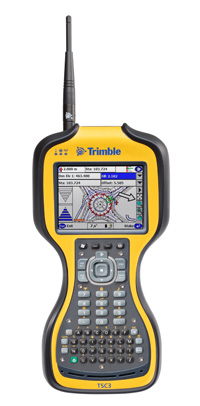New Trimble TSC3 Controller Makes Construction Operations Easier Trimble (NASDAQ: TRMB) introduced the Trimble® TSC3 handheld controller for construction—a powerful and rugged addition to the portfolio of controllers for heavy and highway contractors. With built-in GPS, 3G, Wi-Fi and a 5-megapixel digital camera, construction professionals can stay connected and be equipped with accurate positioning, digital design information and the ability to locate, measure and record information anywhere on the construction site with just one device.
The TSC3 is a key component of the Trimble Connected Site™ portfolio of productivity-enhancing solutions that streamline site measurement and stakeout operations for highways, small and large commercial sites, landfills, waste disposal facilities, tunnels, railway construction and mines. To withstand these harsh construction environments, the TSC3 features a large 4.2 inch, sunlight-readable touch screen display, ruggedized bumpers and long battery life. The controller is shock, dust and water resistant for durability.
The new TSC3 controller features onboard GPS, wireless communications and a digital camera, combining the benefits of multiple handheld devices into a single unit.
With built-in GPS, the TSC3 controller can be used for standalone navigation and measurement purposes. Bluetooth® and optional radio capabilities allow the controller to be used with Trimble Site Positioning Systems, GNSS or total stations, where the highest accuracy is required.
Integrated communications, including Bluetooth, Wi-Fi and a cellular modem, keep data flowing between field instruments, job crews and other stakeholders—for instant connections to the office and clients. The integrated 3G modem also can provide instant access to the Internet for receiving base station corrections as well as emailing and synching files with the Connected Community.
The 5-megapixel digital camera makes it easy to collect site information and visually record site conditions for documentation and quality control. No extra devices or batteries are required, and images are automatically geotagged and associated with measured points for easy identification.
These advanced capabilities and communications incorporated into one handheld allow contractors to realize significant savings by eliminating the time and cost of physically driving data updates to and from the field. Engineers can send design changes or work orders to contractors and crews in the field. The contractor can transfer progress reports, on-site problems, and as-built data back to the office on completion of on-site operations. Site issues and completed work can be photographed and sent back to the office overlaid on the site map—making it easier for managers to make instant decisions regarding remedial work.
Using the two-way data capability reduces delays and rework associated with using outdated information and synching data only at the end of the workday. Reducing delays and rework increases the likelihood that projects will finish on time and under budget. 17/03/2011 |